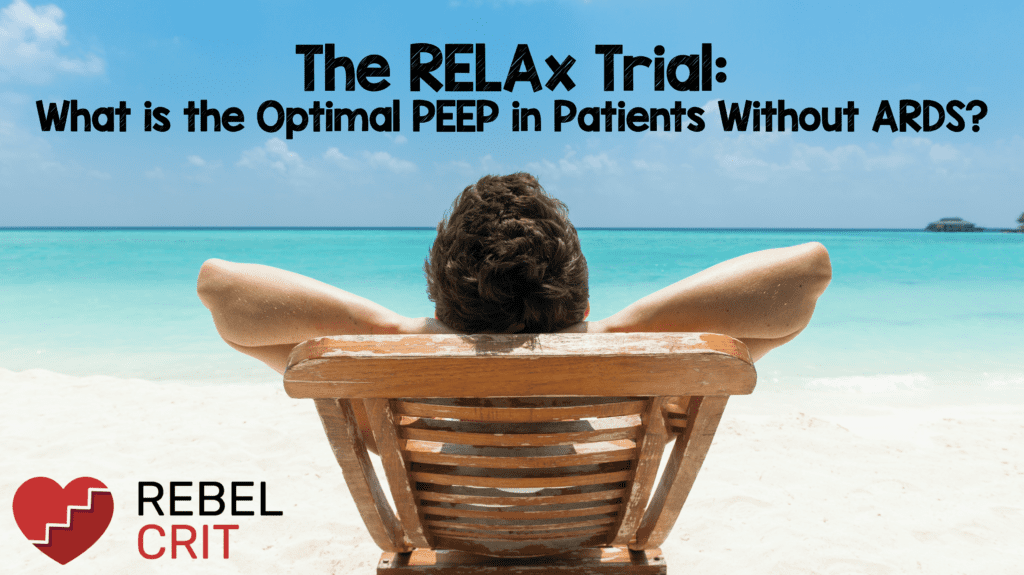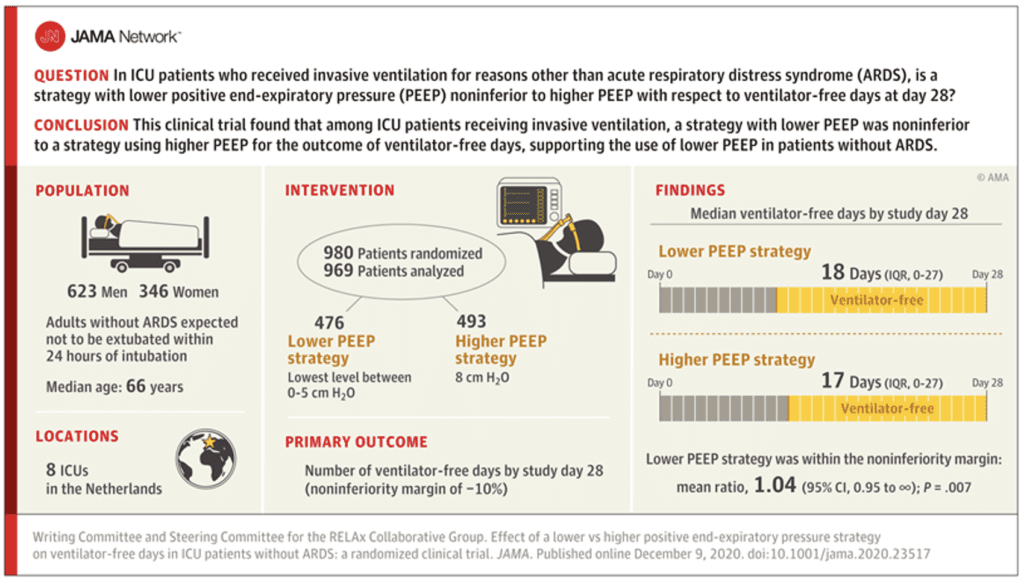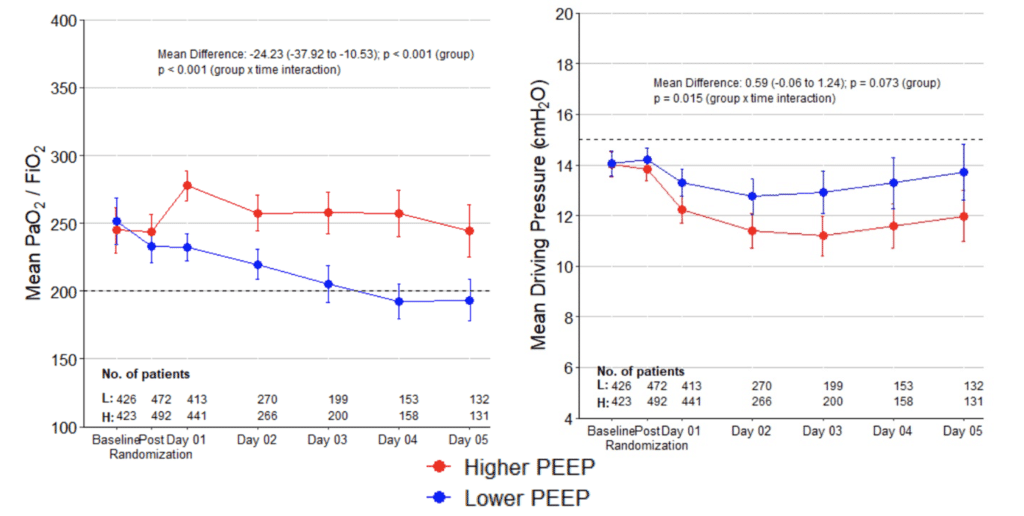
 Background: It has well been established that low tidal volume ventilation minimizes potentially iatrogenic harms of mechanical ventilation. What is less clear is the use of higher positive end expiratory pressure (PEEP) in patients without acute respiratory distress syndrome (ARDS). Use of PEEP helps prevent alveolar collapse and maintains recruitment of atelectatic and diseased alveoli. This improves the distribution of lung aeration over a more homogenously inflated lung surface which in turn may improve oxygenation. Although PEEP reduces cyclical opening and closing of alveoli during ventilation, a higher PEEP could also lead to new lung injury (ventilator-induced lung injury), impair hemodynamics (reducing venous return) and could delay weaning/extubation.
Background: It has well been established that low tidal volume ventilation minimizes potentially iatrogenic harms of mechanical ventilation. What is less clear is the use of higher positive end expiratory pressure (PEEP) in patients without acute respiratory distress syndrome (ARDS). Use of PEEP helps prevent alveolar collapse and maintains recruitment of atelectatic and diseased alveoli. This improves the distribution of lung aeration over a more homogenously inflated lung surface which in turn may improve oxygenation. Although PEEP reduces cyclical opening and closing of alveoli during ventilation, a higher PEEP could also lead to new lung injury (ventilator-induced lung injury), impair hemodynamics (reducing venous return) and could delay weaning/extubation.
Paper: Writing Committee and Steering Committee for the RELAx Collaborative Group. Effect of a Lower vs Higher Postive End-Expiratory Pressure Strategy on Ventilator-Free Days in ICU Patients Without ARDS: A Randomized Clinical Trial. JAMA 2020. PMID: 33295981
Clinical Question: For patients in the ICU who received invasive ventilation for reasons other than ARDS, is a ventilation strategy with lower PEEP noninferior to a strategy using higher PEEP with respect to the number of ventilator-free days at day 28?
What They Did:
- The Restricted vs Liberal Positive End-Expiratory Pressure in Patients Without ARDS (RELAx) trial
- Multicenter, open label, randomized, trial conducted in 8 ICUs in the Netherlands
- Looking for evidence of noninferiority of the lower PEEP strategy compared with the higher PEEP strategy with a noninferiority margin of −10%
- Patients randomized within 1 hour of initiation of ventilation in the ICU in a 1:1 fashion:
- Restricted PEEP (0-5 cm H2O)
- Liberal PEEP (8 cm H2O)
- In both groups the oxygenation targets were 92% to 96% for SpO2 and 60 to 85mmHg for PaO2

Outcomes:
- Primary: Number of ventilator-free days at day 28
-
Secondary: 17 secondary outcomes were predefined
- Length of stay (ICU and hospital)
- Mortality (ICU, hospital, 28-day and 90-day)
- Duration of ventilation among survivors, development of ARDS, VAP, severe atelectasis, severe hypoxemia, and pneumothorax.
- Need for rescue therapies for severe hypoxemia or severe atelectasis, including recruitment maneuvers, prone positioning, and bronchoscopy for opening atelectasis; days with use of vasopressors; and days with use of sedation
Inclusion:
- Adult patients (above 18 years old)
- Patients who were intubated shortly before or after ICU admission and were not expected to be extubated within 24 hours of randomization
Exclusion:
- ARDS
- Age younger than 18 years
- Pregnancy
- Ventilation lasting longer than 12 hours before admission to the ICU
- COPD GOLD class III/IV
- Restrictive pulmonary disease
- Increased and uncontrollable intracranial pressure
- Delayed cerebral ischemia
- Ongoing cardiac ischemia
- Morbid obesity
- Necrotizing fasciitis
- Severe untreatable anemia
- Neurologic diagnosis that could prolong duration of mechanical ventilation
- Carbon monoxide poisoning
- Receiving ECMO
- Participation in another study with similar endpoint
- Previously randomized in trial
Results:
- 980 patients randomized (969 completed the trial)
- Median time between intubation and randomization was 0.6 hours (Range: 0.2 to 1.1hrs)
- 79% of patients were medical admissions
- Reason for intubation:
- Respiratory failure: 30%
- Cardiac arrest: 27%
-
Median Number of ventilator-free days at day 28 (Primary Outcome):
- Lower PEEP strategy (intervention group): 17.7 (Range: 0 – 26.6)
- Higher PEEP strategy: 16.7 (Range: 0 – 26.5)
- Mean ratio, 1.04; 1-sided 95% CI, 0.95-∞; P = .007 for noninferiority
- There was also no difference in this outcome in any of the prespecified subgroups
- 28d Mortality:
- Lower PEEP: 38.4%
- Higher PEEP: 42%
- P = 0.99
- No statistical difference in other mortality rates analyzed
- Need for Rescue Therapy:
- Lower PEEP Strategy: 19.7%
- Higher PEEP Strategy: 14.6%
- Absolute difference: 5.14 (95% CI 0.40 to 9.91; p = 0.54)
- No other secondary outcomes showed significant differences between the two groups including occurrence of ARDS, VAP, pneumothorax, or severe atelectasis

Strengths:
- Largest randomized, multi-center clinical trial assessing lower PEEP vs higher PEEP strategies in patients without ARDS
- Baseline characteristics of the two groups were similar including age, sex, SOFA scores, ventilator modes
- Both groups followed strict protocols for standard care and weaning from the ventilator
- Very few patients were lost to follow up for the primary outcome
- Performed a per protocol analysis including only patients who completed PEEP titrations according to the study protocol
- Designed to minimize bias by concealing allocation and following a clear protocol which was strictly adhered to
Limitations:
- Blinding not possible due to the interventions being studied
- APACHE IV scores were higher among the “high PEEP” group which may indicate that these patients were generally sicker
- Choosing a PEEP of 8 as the “standard of care” to compare with the intervention
- The reason for intubation was unbalanced between groups. This is an important point to understand. More patients in the lower PEEP group had postoperative ventilation (16.4% vs 12.0%) and more patients in the higher PEEP group had cardiac arrest (25.8% vs 28.8%). From a requiring mechanical ventilation duration these imbalances will favor the lower PEEP strategy
- Many patients were missed and out of 2869 patients screened including 947 who were eligible but not enrolled. This becomes a convenience sample which can bias the results
- Groups were well balanced in terms of sedation level, heart rate, MAP, administered fluids, transfusions, vasopressor support and SOFA score
Discussion:
- Mortality at 28d and duration of ventilation among survivors were not included in the original protocol but later added as secondary outcomes
- Authors also state that it was difficult to collect complete and reliable data for the Therapeutic Intervention Scoring System score and the Nursing Activities Score and therefore not included in this publication
- There are plans to report on cardiac performance, lung aeration, and systemic inflammation assessed by ultrasound and plasma biomarkers in a subset of the patients enrolled in future publications
- The -10% noninferiority margin represented 0.5d of ventilation or 1.6 ventilator free days. According to the authors this threshold was chosen based on a clinical point of view. Essentially <12hrs in duration of ventilation or 1.6 ventilator free days comparing the two strategies
- This trial tells us that a lower PEEP strategy is as good as a higher PEEP strategy, but what this study does not tell us is if a lower PEEP strategy is superior to a higher PEEP strategy
- Although not statistically significant, the point estimate for the percentage of patients requiring rescue strategies was greater in the lower PEEP group (Lower PEEP 19.7% vs Higher PEEP 14.6%).
- Also, not statistically significant, the point estimate for the percentage of patients with severe hypoxemia (defined as a decrease in SpO2 to less than 88% or PaO2 to less than 55 mmHg) was greater in the lower PEEP group (Lower PEEP 20.6% vs Higher PEEP 17.6%).
- Finally, the reason for intubation showed a difference in ventilator-free days at day 28 as well. If intubated for respiratory failure (Lower PEEP 11.1 vs Higher PEEP 17.7) vs other indications (Lower PEEP 21.2 vs Higher PEEP 16.3).
- It may be that the trial was underpowered to detect a statistically significant difference and that for some patients a lower PEEP strategy could be inferior
- Only a small portion of patient in this trial (30%) were intubated for respiratory failure. Therefore, for everyone else in the study (70%) of patients the reason to extubate will not be driven by pulmonary issues.
- Non-inferiority study design is unusual in my opinion, as this is typically used to test a new treatment vs standard treatment. This makes sense when there is a reason to consider the new treatment (i.e. cheaper, additional effects, etc). Not sure this is the case when comparing a lower PEEP to a higher PEEP
- I find it frustrating when important information is hidden in the supplementary info, but in this case, we can see that a lower PEEP strategy lead to lower P/F ratios and higher driving pressures, which is pretty telling

- The ART trial in 2017 showed that a lower PEEP strategy was associated with better mortality outcomes when compared with a PEEP titration strategy in ARDS patients [1]
- A meta-analysis published in 2016 showed that higher PEEP was not associated with lower mortality or less duration on the ventilator, however it provided less chances of ARDS and hypoxemia [2]
- Patients’ BMI was around 26 in both groups which makes it difficult to generalize this approach in a population with higher BMI. In fact, patients with higher BMI are known to require higher PEEP to start with.
- It’s unclear why the authors picked 8 of PEEP as the reference point for comparison. A patient’s “optimal PEEP” may very well be based on their body habitus and/or lung physiology.
Author conclusion: “Among patients in the ICU without ARDS who were expected not to be extubated within 24 hours, a lower PEEP strategy was noninferior to a higher PEEP strategy with regard to the number of ventilator-free days at day 28. These findings support the use of lower PEEP in patients without ARDS.”
Take-home point: In this trial a lower PEEP strategy was shown to be noninferior to higher PEEP in non-ARDS patients (i.e. as good as). However, there are some concerning findings of increased rates of severe hypoxemia, need for rescue strategies, decreased P/F ratios, and increased driving pressures in the lower PEEP group compared to the higher PEEP group. Finding the optimal PEEP can be challenging, and likely tied to the degree of recruitable alveoli. In some patient populations, particularly obese patients (which were excluded from this trial), for example, this will require applying clinical judgement and understanding the benefit vs the harm of PEEP which depends on the balance of alveolar recruitment vs overdistention (i.e. the sweet spot).
Guest Post By

Amin Demerdash, MD
Critical Care Medicine Fellow
Geisinger Medical Center
Danville, PA
For More on This Topic Checkout:
- PulmCrit: I’m Upset About the RELAX Trial
References:
- Neto AS et al. Associations Between Positive End-Expiratory Pressure and Outcome of Patients Without ARDS at Onset of Ventilation: A Systematic Review and Meta-Analysis of Randomized Controlled Trials. Ann Intensive Care 2016. PMID: 27813023
- Cavalcanti AB et al. Effect of Lung Recruitment and Titrated Positive End-Expiratory Pressure (PEEP) vs Low PEEP on Mortality in Patients With Acute Respiratory Distress Syndrome: A Randomized Clinical Trial. JAMA 2017. PMID: 28973363
- Writing Committee and Steering Committee for the RELAx Collaborative Group. Effect of a Lower vs Higher Postive End-Expiratory Pressure Strategy on Ventilator-Free Days in ICU Patients Without ARDS: A Randomized Clinical Trial. JAMA 2020. PMID: 33295981
- Sahetya SK et al. Searching for the Optimal PEEP in Patients Without ARDS: High, Low, or in Between? JAMA 2020. PMID: 33295963
Post Peer Reviewed By: Salim R. Rezaie, MD (Twitter: @srrezaie)
The post The RELAx Trial: What is the Optimal PEEP in Patients Without ARDS? appeared first on REBEL EM - Emergency Medicine Blog.
